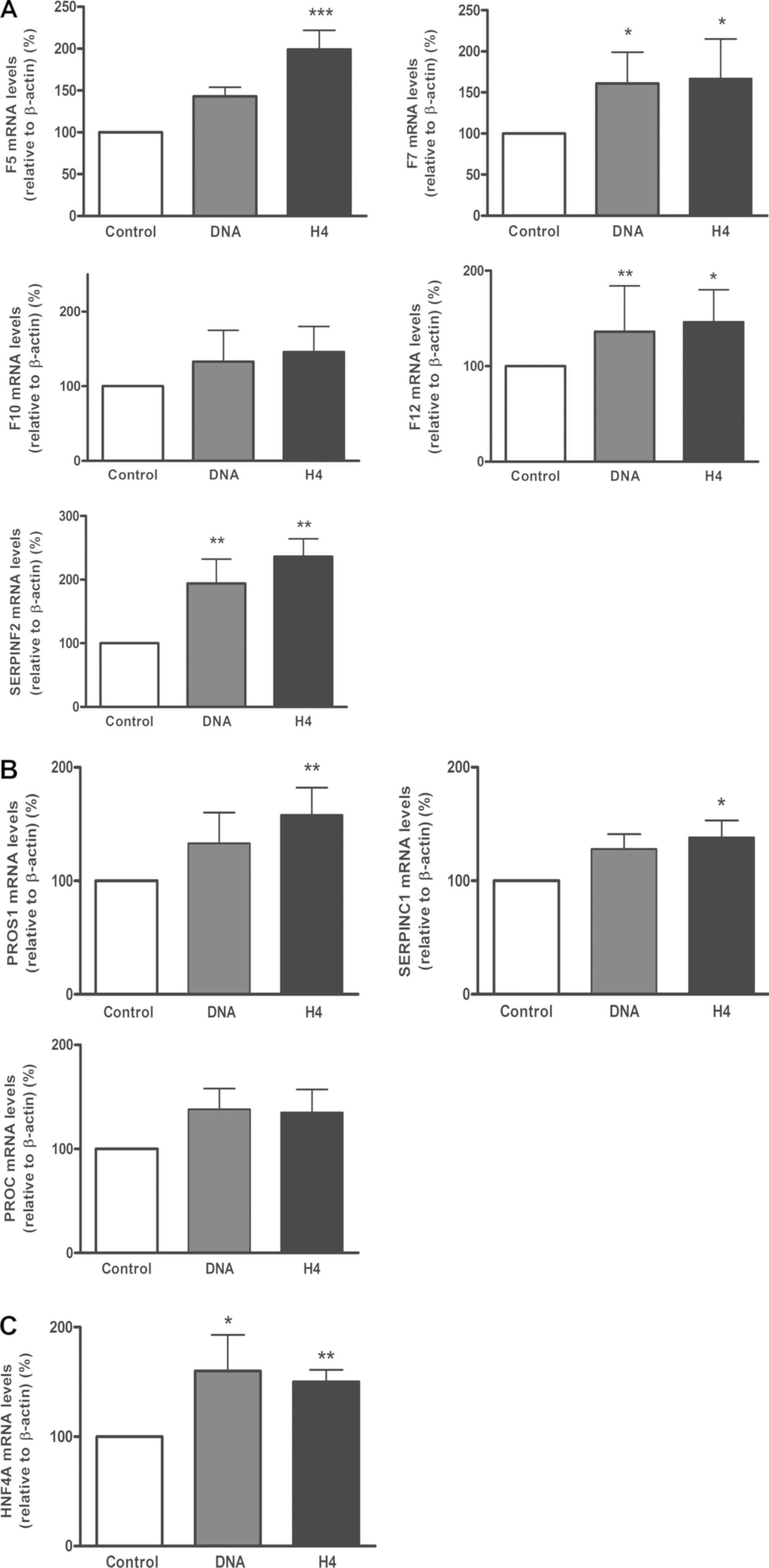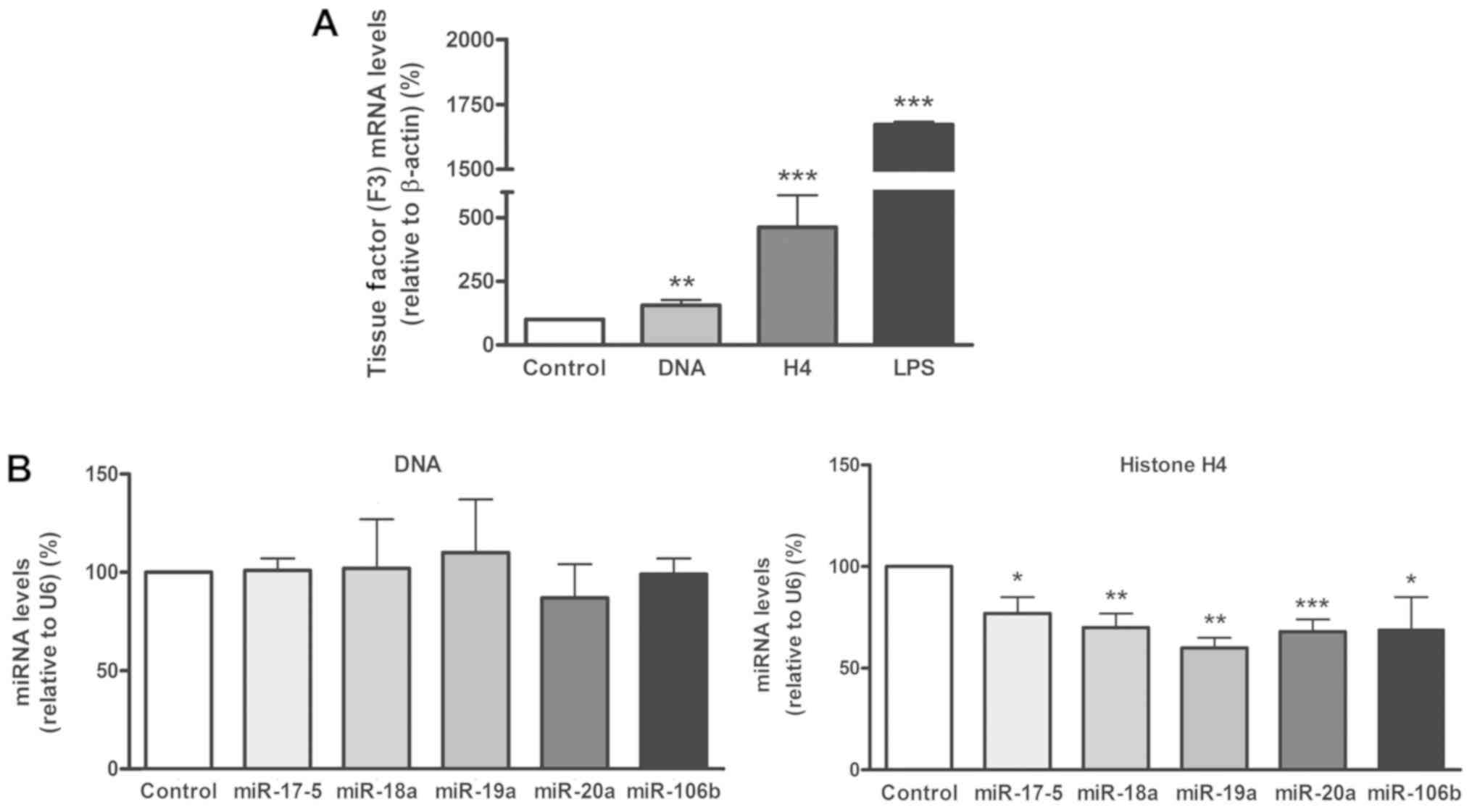|
1
|
Engelmann B and Massberg S: Thrombosis as
an intravascular effector of innate immunity. Nat Rev Immunol.
13:34–45. 2013.PubMed/NCBI View
Article : Google Scholar
|
|
2
|
Swystun LL and Liaw PC: The role of
leukocytes in thrombosis. Blood. 128:753–762. 2016.PubMed/NCBI View Article : Google Scholar
|
|
3
|
Urban CF, Ermert D, Schmid M, Abu-Abed U,
Goosmann C, Nacken W, Brinkmann V, Jungblut PR and Zychlinsky A:
Neutrophil extracellular traps contain calprotectin, a cytosolic
protein complex involved in host defense against Candida
albicans. PLoS Pathog. 5(e1000639)2009.PubMed/NCBI View Article : Google Scholar
|
|
4
|
Zawrotniak M and Rapala-Kozik M:
Neutrophil extracellular traps (NETs) - formation and implications.
Acta Biochim Pol. 60:277–284. 2013.PubMed/NCBI
|
|
5
|
Rao AN, Kazzaz NM and Knight JS: Do
neutrophil extracellular traps contribute to the heightened risk of
thrombosis in inflammatory diseases? World J Cardiol. 7:829–842.
2015.PubMed/NCBI View Article : Google Scholar
|
|
6
|
Lee KH, Kronbichler A, Park DD, Park Y,
Moon H, Kim H, Choi JH, Choi Y, Shim S, Lyu IS, et al: Neutrophil
extracellular traps (NETs) in autoimmune diseases: A comprehensive
review. Autoimmun Rev. 16:1160–1173. 2017.PubMed/NCBI View Article : Google Scholar
|
|
7
|
Knight JS, Luo W, O'Dell AA, Yalavarthi S,
Zhao W, Subramanian V, Guo C, Grenn RC, Thompson PR, Eitzman DT, et
al: Peptidylarginine deiminase inhibition reduces vascular damage
and modulates innate immune responses in murine models of
atherosclerosis. Circ Res. 114:947–956. 2014.PubMed/NCBI View Article : Google Scholar
|
|
8
|
Tang S, Zhang Y, Yin SW, Gao XJ, Shi WW,
Wang Y, Huang X, Wang L, Zou LY, Zhao JH, et al: Neutrophil
extracellular trap formation is associated with autophagy-related
signalling in ANCA-associated vasculitis. Clin Exp Immunol.
180:408–418. 2015.PubMed/NCBI View Article : Google Scholar
|
|
9
|
Berger-Achituv S, Brinkmann V, Abed UA,
Kühn LI, Ben-Ezra J, Elhasid R and Zychlinsky A: A proposed role
for neutrophil extracellular traps in cancer immunoediting. Front
Immunol. 4(48)2013.PubMed/NCBI View Article : Google Scholar
|
|
10
|
Fuchs TA, Brill A, Duerschmied D,
Schatzberg D, Monestier M, Myers DD Jr, Wrobleski SK, Wakefield TW,
Hartwig JH and Wagner DD: Extracellular DNA traps promote
thrombosis. Proc Natl Acad Sci USA. 107:15880–15885.
2010.PubMed/NCBI View Article : Google Scholar
|
|
11
|
Brill A, Fuchs TA, Savchenko AS, Thomas
GM, Martinod K, De Meyer SF, Bhandari AA and Wagner DD: Neutrophil
extracellular traps promote deep vein thrombosis in mice. J Thromb
Haemost. 10:136–144. 2012.PubMed/NCBI View Article : Google Scholar
|
|
12
|
Semeraro F, Ammollo CT, Morrissey JH, Dale
GL, Friese P, Esmon NL and Esmon CT: Extracellular histones promote
thrombin generation through platelet-dependent mechanisms:
Involvement of platelet TLR2 and TLR4. Blood. 118:1952–1961.
2011.PubMed/NCBI View Article : Google Scholar
|
|
13
|
Kim JE, Yoo HJ, Gu JY and Kim HK: Histones
Induce the Procoagulant Phenotype of Endothelial Cells through
Tissue Factor Up-Regulation and Thrombomodulin Down-Regulation.
PLoS One. 11(e0156763)2016.PubMed/NCBI View Article : Google Scholar
|
|
14
|
Ammollo CT, Semeraro F, Xu J, Esmon NL and
Esmon CT: Extracellular histones increase plasma thrombin
generation by impairing thrombomodulin-dependent protein C
activation. J Thromb Haemost. 9:1795–1803. 2011.PubMed/NCBI View Article : Google Scholar
|
|
15
|
Yang X, Li L, Liu J, Lv B and Chen F:
Extracellular histones induce tissue factor expression in vascular
endothelial cells via TLR and activation of NF-κB and AP-1. Thromb
Res. 137:211–218. 2016.PubMed/NCBI View Article : Google Scholar
|
|
16
|
Gould TJ, Lysov Z, Swystun LL, Dwivedi DJ,
Zarychanski R, Fox-Robichaud AE and Liaw PC: Canadian Critical Care
Translational Biology Group: Extracellular Histones Increase Tissue
Factor Activity and Enhance Thrombin Generation by Human Blood
Monocytes. Shock. 46:655–662. 2016.PubMed/NCBI View Article : Google Scholar
|
|
17
|
Bhagirath VC, Dwivedi DJ and Liaw PC:
Comparison of the Proinflammatory and Procoagulant Properties of
Nuclear, Mitochondrial, and Bacterial DNA. Shock. 44:265–271.
2015.PubMed/NCBI View Article : Google Scholar
|
|
18
|
Mann KG, Nesheim ME, Tracy PB, Hibbard LS
and Bloom JW: Assembly of the prothrombinase complex. Biophys J.
37:106–107. 1982.PubMed/NCBI View Article : Google Scholar
|
|
19
|
Krishnaswamy S: The transition of
prothrombin to thrombin. J Thromb Haemost. 11 (Suppl 1):265–276.
2013.PubMed/NCBI View Article : Google Scholar
|
|
20
|
O'Hara PJ, Grant FJ, Haldeman BA, Gray CL,
Insley MY, Hagen FS and Murray MJ: Nucleotide sequence of the gene
coding for human factor VII, a vitamin K-dependent protein
participating in blood coagulation. Proc Natl Acad Sci USA.
84:5158–5162. 1987.PubMed/NCBI
|
|
21
|
Didiasova M, Wujak L, Schaefer L and
Wygrecka M: Factor XII in coagulation, inflammation and beyond.
Cell Signal. 51:257–265. 2018.PubMed/NCBI View Article : Google Scholar
|
|
22
|
Esmon NL, Owen WG and Esmon CT: Isolation
of a membrane-bound cofactor for thrombin-catalyzed activation of
protein C. J Biol Chem. 257:859–864. 1982.PubMed/NCBI
|
|
23
|
Hayhurst GP, Lee Y-H, Lambert G, Ward JM
and Gonzalez FJ: Hepatocyte nuclear factor 4alpha (nuclear receptor
2A1) is essential for maintenance of hepatic gene expression and
lipid homeostasis. Mol Cell Biol. 21:1393–1403. 2001.PubMed/NCBI View Article : Google Scholar
|
|
24
|
Björk I and Olson ST: Antithrombin. A
bloody important serpin. Adv Exp Med Biol. 425:17–33.
1997.PubMed/NCBI
|
|
25
|
Kettle P and Mayne EE: A bleeding disorder
due to deficiency of alpha 2-antiplasmin. J Clin Pathol.
38:428–429. 1985.PubMed/NCBIPubMed/NCBI
|
|
26
|
Furie B and Furie BC: The molecular basis
of blood coagulation. Cell. 53:505–518. 1988.PubMed/NCBI View Article : Google Scholar
|
|
27
|
Teruel R, Pérez-Sánchez C, Corral J,
Herranz MT, Pérez-Andreu V, Saiz E, García-Barberá N,
Martínez-Martínez I, Roldán V, Vicente V, et al: Identification of
miRNAs as potential modulators of tissue factor expression in
patients with systemic lupus erythematosus and antiphospholipid
syndrome. J Thromb Haemost. 9:1985–1992. 2011.PubMed/NCBI View Article : Google Scholar
|
|
28
|
Ramboer E, De Craene B, De Kock J,
Vanhaecke T, Berx G, Rogiers V and Vinken M: Strategies for
immortalization of primary hepatocytes. J Hepatol. 61:925–943.
2014.PubMed/NCBI View Article : Google Scholar
|
|
29
|
Livak KJ and Schmittgen TD: Analysis of
relative gene expression data using real-time quantitative PCR and
the 2(-Δ Δ C(T)) method. Methods. 25:402–408. 2001.PubMed/NCBI View Article : Google Scholar
|
|
30
|
Salloum-Asfar S, Arroyo AB, Teruel-Montoya
R, García-Barberá N, Roldán V, Vicente V, Martínez C and
González-Conejero R: miRNA-Based Regulation of Hemostatic Factors
through Hepatic Nuclear Factor-4 Alpha. PLoS One.
11(e0154751)2016.PubMed/NCBI View Article : Google Scholar
|
|
31
|
Erdmann D and Heim J: Orphan nuclear
receptor HNF-4 binds to the human coagulation factor VII promoter.
J Biol Chem. 270:22988–22996. 1995.PubMed/NCBI View Article : Google Scholar
|
|
32
|
Tarumi T, Kravtsov DV, Zhao M, Williams SM
and Gailani D: Cloning and characterization of the human factor XI
gene promoter: Transcription factor hepatocyte nuclear factor
4alpha (HNF-4alpha ) is required for hepatocyte-specific expression
of factor XI. J Biol Chem. 277:18510–18516. 2002.PubMed/NCBI View Article : Google Scholar
|
|
33
|
Brand K, Fowler BJ, Edgington TS and
Mackman N: Tissue factor mRNA in THP-1 monocytic cells is regulated
at both transcriptional and posttranscriptional levels in response
to lipopolysaccharide. Mol Cell Biol. 11:4732–4738. 1991.PubMed/NCBI View Article : Google Scholar
|
|
34
|
Xu J, Zhang X, Pelayo R, Monestier M,
Ammollo CT, Semeraro F, Taylor FB, Esmon NL, Lupu F and Esmon CT:
Extracellular histones are major mediators of death in sepsis. Nat
Med. 15:1318–1321. 2009.PubMed/NCBI View Article : Google Scholar
|
|
35
|
Noubouossie DF, Whelihan MF, Yu YB,
Sparkenbaugh E, Pawlinski R, Monroe DM and Key NS: In vitro
activation of coagulation by human neutrophil DNA and histone
proteins but not neutrophil extracellular traps. Blood.
129:1021–1029. 2017.PubMed/NCBI View Article : Google Scholar
|
|
36
|
Farsetti A, Moretti F, Narducci M, Misiti
S, Nanni S, Andreoli M, Sacchi A and Pontecorvi A: Orphan receptor
hepatocyte nuclear factor-4 antagonizes estrogen receptor
alpha-mediated induction of human coagulation factor XII gene.
Endocrinology. 139:4581–4589. 1998.PubMed/NCBI View Article : Google Scholar
|
|
37
|
Tremp GL, Duchange N, Branellec D,
Cereghini S, Tailleux A, Berthou L, Fievet C, Touchet N, Schombert
B, Fruchart JC, et al: A 700-bp fragment of the human antithrombin
III promoter is sufficient to confer high, tissue-specific
expression on human apolipoprotein A-II in transgenic mice. Gene.
156:199–205. 1995.PubMed/NCBI View Article : Google Scholar
|
|
38
|
López-Terrada D, Cheung SW, Finegold MJ
and Knowles BB: Hep G2 is a hepatoblastoma-derived cell line. Hum
Pathol. 40:1512–1515. 2009.PubMed/NCBI View Article : Google Scholar
|
|
39
|
Lee YS, Kim YH, Jung YS, Kim KS, Kim DK,
Na SY, Lee JM, Lee CH and Choi HS: Hepatocyte Toll-like receptor 4
mediates lipopolysaccharide-induced hepcidin expression. Exp Mol
Med. 49(e408)2017.PubMed/NCBI View Article : Google Scholar
|
|
40
|
Teruel-Montoya R, Rosendaal FR and
Martínez C: MicroRNAs in hemostasis. J Thromb Haemost. 13:170–181.
2015.PubMed/NCBI View Article : Google Scholar
|
|
41
|
Fish RJ and Neerman-Arbez M: Fibrinogen
gene regulation. Thromb Haemost. 108:419–426. 2012.PubMed/NCBI View Article : Google Scholar
|
|
42
|
Salloum-Asfar S, Teruel-Montoya R, Arroyo
AB, García-Barberá N, Chaudhry A, Schuetz E, Luengo-Gil G, Vicente
V, González-Conejero R and Martínez C: Regulation of coagulation
factor XI expression by microRNAs in the human liver. PLoS One.
9(e111713)2014.PubMed/NCBI View Article : Google Scholar
|
|
43
|
B Arroyo A, Salloum-Asfar S, Pérez-Sánchez
C, Teruel-Montoya R, Navarro S, García-Barberá N, Luengo-Gil G,
Roldán V, Hansen JB, López-Pedrera C, et al: Regulation of TFPIα
expression by miR-27a/b-3p in human endothelial cells under normal
conditions and in response to androgens. Sci Rep.
7(43500)2017.PubMed/NCBI View Article : Google Scholar
|
|
44
|
Philippe L, Alsaleh G, Suffert G, Meyer A,
Georgel P, Sibilia J, Wachsmann D and Pfeffer S: TLR2 expression is
regulated by microRNA miR-19 in rheumatoid fibroblast-like
synoviocytes. J Immunol. 188:454–461. 2012.PubMed/NCBI View Article : Google Scholar
|
|
45
|
Philippe L, Alsaleh G, Pichot A, Ostermann
E, Zuber G, Frisch B, Sibilia J, Pfeffer S, Bahram S, Wachsmann D,
et al: miR-20a regulates ASK1 expression and TLR4-dependent
cytokine release in rheumatoid fibroblast-like synoviocytes. Ann
Rheum Dis. 72:1071–1079. 2013.PubMed/NCBI View Article : Google Scholar
|
















